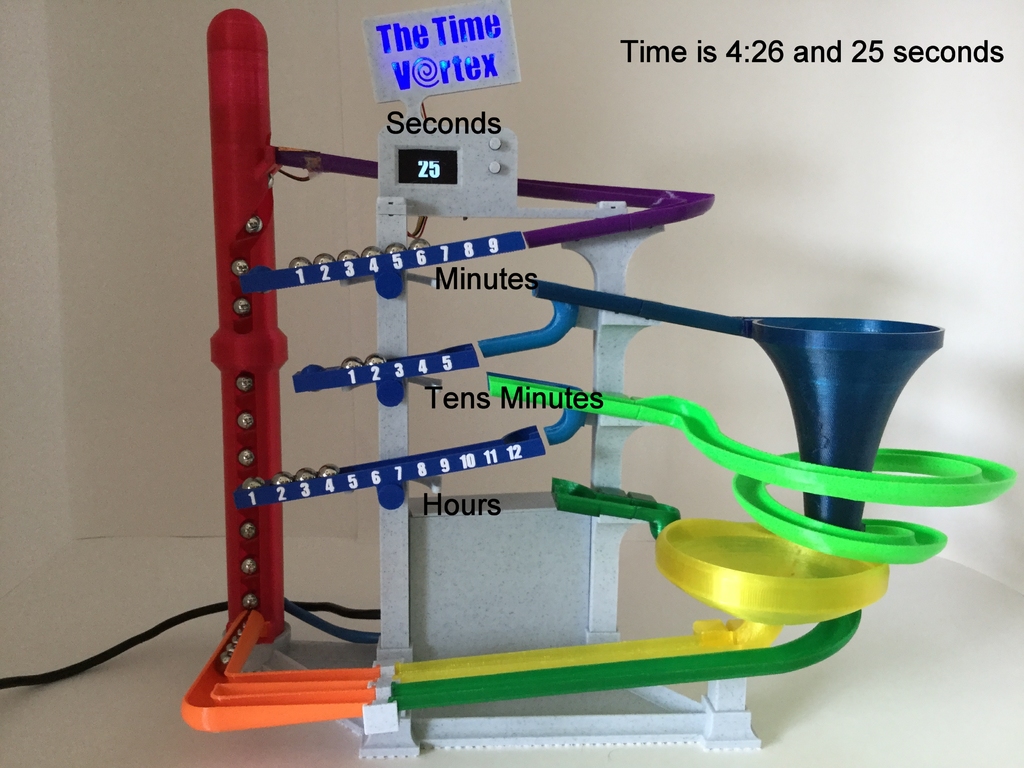
The Time Vortex Clock
thingiverse
The concept behind a ball bearing clock was inspired by the "Idle-Tyme Clock" and "Time Machine Clock". However, unlike those designs that have a complex maze of tracks to deliver the balls back to the start, my design features two funnels and a spiral. Additionally, whereas those designs rely on precise motor timing for accurate timekeeping, with accuracy degrading as the motor wears, my design is not dependent on motor speed. The motor is turned on once a minute and then off when a ball bearing reaches the top, regardless of whether it takes one second or 59 seconds. To read this unique clock, start at the bottom and work your way up. The lower arm displays the hour, the middle arm shows tens of minutes, and the upper arm displays the minutes, while the OLED display will show the seconds. The mechanism works as follows: once a minute, a ball is delivered to the top track that feeds the minutes arm. When this arm reaches nine, the next ball causes it to tip, releasing all the balls, most of which return to the bottom, but the ball that triggered the tipping will go down a different track feeding the tens of minutes arm. If this arm is full, it will cause it to tip and empty, allowing the ball that triggered it to feed the hours arm. This means the top arm dumps every ten minutes, the tens minutes track empties every hour, and the hours arm empties every 12 hours. When the clock transitions from 12:59 to 1:00, all three arms will dump simultaneously. The Time Vortex has a demo mode where balls are delivered continuously or with a small delay. Video in continuous demo mode: https://youtu.be/z7Dq6jFfYC8 Slow motion video of the big dump, top view: https://www.youtube.com/watch?v=k4OKb21Jx5k Slow motion video of the big dump, front view: https://www.youtube.com/watch?v=6scgrva1QpQ Video in demo mode with a 1-second delay: https://www.youtube.com/watch?v=LVn0acPUzjw Boring video in normal clock mode: https://www.youtube.com/watch?v=vzpCU1eFGS0 Other necessary components include: * At least 29 ball bearings, each with a diameter of 9.5mm or 3/8 inch. * An N20 metal gear motor (speed is not critical; I'm using a 12v 100RPM motor). * An Arduino nano or clone. * A DS3231 RTC module. * A .96-inch 128x64 I2C SSD1306 OLED display. * Two tactile push-button switches measuring 6mm x 6mm x 5mm. * Seven Geekcreit WS2812B SMD LEDs. * One 2N3904 NPN transistor (or similar). * A 1K ohm resistor. * One 1N4948 diode (or similar). * A .1uf (100nf) capacitor. * Some copper foil. * A circuit board (the holder is for a board measuring 77mm x 60mm x 1.2mm). * Some small connectors (I used micro JST 1.25mm connectors, two-pin and four-pin). * Some wire (CAT5 cable works nicely). * Optional: five M3 x 15 screws and nuts for adjustable feet. I cut some old circuit board to size; it might be a bit thin. If needed, I can supply a holder for thicker boards.
With this file you will be able to print The Time Vortex Clock with your 3D printer. Click on the button and save the file on your computer to work, edit or customize your design. You can also find more 3D designs for printers on The Time Vortex Clock.
